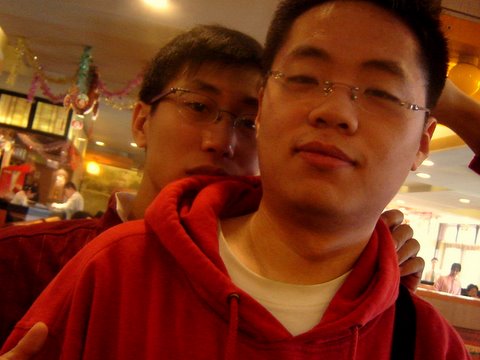新闻媒体生命力的一种表述
深夜找到一篇旧文,是去年《财经》在香河天下第一城开全体年中大会时我的发言。所有想法都没变,只是第一条,现在看来更紧迫。要说明,时值春夏之交,所…
Posted via email from N3
“Stay hungry Stay foolish”——Steven Jobs
Posted via email from N3
| 三大网站的基本资料 | ||||||
| 企业 | 创办时间 | 创始人 | 籍贯 | 代言人 | 员工 | 销售业绩 |
| U88.cn加盟致富网 | 2004-3-1 | 吕才红 | 安徽 | 王刚 | 40-50 | 过亿 |
| 3158.cn致富信息网 | 2004-3-15 | 未知 | 重庆 | 张铁林 | 40-50 | 7000万以上 |
| 28.cn商机网 | 2004-4 | 程家 | 湖北 | 范伟 | 200-300 | 过亿 |
Posted via email from N3
 So Oracle ends up owning Sun Microsystems. I couldn’t believe it at first, thinking somehow that it was all just a ploy to get IBM to pull out the Big Checkbook. And while the deal may have begun with that thought glowing in the mind of Jonathan Schwartz, it ends with the heart of Sun moving a few miles up 101 to where it will certainly die.
So Oracle ends up owning Sun Microsystems. I couldn’t believe it at first, thinking somehow that it was all just a ploy to get IBM to pull out the Big Checkbook. And while the deal may have begun with that thought glowing in the mind of Jonathan Schwartz, it ends with the heart of Sun moving a few miles up 101 to where it will certainly die.
IBM doesn’t want Sun and is gleeful with the idea of Oracle taking over, as you’ll learn if you read the internal IBM memo copied below. Big Blue does a very good job here of explaining its thinking and most of it makes sense. No white knight.
But what will Oracle DO with Sun? Make a lot of trouble for IBM, or try to, I think, but even doing that will be a challenge. Java is deliberately unprotected by patents and subject to enough industry oversight that Larry Ellison can’t just kill it or somehow make it proprietary overnight. MySQL could be killed, but for Open Source that just means it would branch and be reborn a day or a week later mostly intact and protected by nerds who would by then be very, very angry. On a positive side Oracle will undoubtedly make some very useful database appliances and may well come to dominate that as yet non-existent product space.
But for the most part what Oracle will do with Sun is show a quick and dirty profit by slashing and burning at a produgious rate, cutting the plenty of fat (and a fair amount of muscle) still at Sun. If you read the Oracle press release, the company is quite confident it is going to make a lot of money on this deal starting right away. How can they be so sure?
It’s easy. First drop all the bits of Sun that don’t make money. Then drop all the bits that don’t fit in Oracle’s strategic vision. Bring the back office entirely into Redwood Shores. The cut what overhead is left to match the restructured business. Sell SPARQ to some Asian OEM. Cut R&D by 80 percent, saving $2.4 billion per year. I’m guessing sell StorageTek, maybe even to IBM. And on and on. Gut Sun and milk what remains.
The plan has to have been on the table since last Fall when Andy Bechtolsheim, the mine canary of Sun’s executive suite, left the company for the second time. Even then it was clear that the options were a good sale or murder-suicide.
I blame Schwartz, of course, but I don’t blame him, too, because I think he had little choice. He just wasn’t a lucky guy, it turned out.
So what’s next for Sun? Nothing, I think.
Here’s the internal IBM memo on the deal:
PPublished on 21 April 2009
News home > Top stories >
Oracle enters a twilight zone
The acquistion of Sun creates opportunities for IBM.
The surprise announcement of the Oracle deal to buy Sun Microsystems creates
some new opportunities for IBM. Since its days as a bright star in the dot-com
era, Sun gradually lost its place in the UNIX server market it once dominated.
How does IBM stand to gain, if and when this transaction closes?
Momentum
First, momentum. According to IDC’s latest report, IBM’s share of the $17 billion
UNIX server market grew to more than 37% in 2008 while Sun’s share fell to 28
percent; since 2000 IBM has gained 19 points of share, while Sun has lost 7
points.
Since 2006, the number of clients that have migrated from Sun to IBM Power
Systems has grown 10% annually to more than 750 clients as of 1Q 2009. IBM’s
Migration Factory has eased the transition for these Sun clients to the Power
platform with its leadership performance and virtualization technologies. In
addition, IBM technologies such as its Infosphere Information Server have enabled
a steady stream of Oracle clients to migrate from Oracle’s high-maintenenace-fee
database to IBM DB2 and Informix data servers. The fact that Oracle and Sun will
share the same address does nothing to change these trends.
Openness
Second, openness. IBM offers every client the greatest choice and best value in
both hardware and software to meet their business needs. IBM will continue to
support Power Systems clients that have chosen Oracle’s middleware or database,
just as we will continue to support the IBM middleware and data server needs of
Sun server clients.
Oracle, after acquiring many software vendors partial to IBM server platforms, has
long promised to protect the compatibility of IBM servers, notably Power; Oracle
clients will continue to demand this compatibility moving forward.
Oracle’s self-serving interpretation of “open” sharply contrasts with IBM’s
championing of Linux and the broad open source community. Despite this, clients
committed to IBM middleware have forced Oracle to maintain long-term
compatibility with IBM software through previous Oracle acquisitions of IBM
Business Partners such as PeopleSoft and Siebel, and this bodes well for Java
News
4/21/2009
http://w3.ibm.com/news/w3news/top_stories/2009/04/stgswg_sunoracle.html
technology. Oracle is unlikely to make sweeping changes – it’s the subtle changes
we’ll watch for. MySQL, an open-source competitor to Oracle’s database that was
acquired by Sun last year, should pose an interesting test of Oracle’s openness.
Sun’s billion-dollar acquisition was hurting Oracle. If they kill MySQL they could
alienate the open-source community, which loved Sun. If they keep it, they may
not have the ability to capitalize on it.
Client confidence
Third, client confidence. IBM’s consistent roadmaps and disciplined delivery enable
clients to effectively gauge the long-term value of their investments in systems,
middleware and services. Sun’s much-publicized business problems will not be
erased in the minds of clients by the Oracle acquisition. If anything, significant
questions are raised. For instance, the omission of any mention of SPARC in
yesterday’s statements from Sun and Oracle is certain to make Sun hardware
loyalists very anxious about a future where Oracle is calling the shots.
Earlier this month the latest of a long line of executive departures from Sun was
its lead processor designer who headed development of Sun’s long-promised and
much-delayed next-gen RISC processor, codenamed “Rock.” The future direction
of Solaris in the hands of Oracle is also unknown, while IBM’s substantial
investments in the future of AIX and Linux are ongoing and well known.
Cost advantage
Finally, cost advantage. In today’s economy, clients are looking to reduce the
heavy maintenance costs associated with Oracle database use. IBM hardware and
software technologies together provide a significantly lower total cost of
ownership.
Several Wall Street analyst reports yesterday saw Oracle’s move as defensive in
response to a dwindling ecosystem. Other observers see the Sun deal as an
attempt to emulate IBM’s successful solutions strategy. However, Oracle’s ability
to manage this type of integration is unproven. Oracle’s remains an application-
led play while IBM has a thriving software ecosystem of application developers
and a much different acquisition style.
Whatever changes take place within Oracle and Sun, one thing that remains
unchanged is IBM’s position of strength and our proven ability to win against both
these competitors.
More details on the Oracle-Sun announcement are posted on the Market Insights
Web site .
For more information concerning this article, please contact Smith, Bruce P.
(brucesmi@us.ibm.com).
Posted via email from N3
昨晚以来,关于 Portfolio 这本杂志即将关闭的消息就在媒体业引起了小小的波澜:感叹者有之,疑惑者有之,冷眼者有之。
虽然每周死一份百年老报已经让人审美疲劳,但一份创办只两年、起手势就投资一个亿美元的杂志就此突然死亡,就郁闷了:老报倒掉,还可以说是因为它不够与时俱进,新刊关张,有什么借口可言?
而且,之所以这事情在国内被关注,还有一个有趣的理由:国内有数量不少的杂志在参考、模仿甚至山寨它(我可以随口数出3、4本)。怎承想偶像变了先烈?
在其创刊之初,我曾在博客里谈过它,之后对它也算关注,所以如果硬要总结,倒是可以掰着手指列举一些失败的理由:从来没有自己的核心读者群;杂志质量下滑严重;核心记者先后离开;杂志内《华尔街日报》帮和《纽约时报》帮有文化冲突;主编 Joanna Lipman 据说是个糟糕的主编……
但我毕竟是局外人,不冒充内行。还是从读者的角度,来谈谈我自己个儿的理解。
回过头来说个基础问题:Portfolio 是什么?
这杂志,创办之初是奔着混搭去的:商业+时尚。左手希望就着商业话题打入高薪阶层,右手想以浮华世界撬开奢侈品广告主的钱包。因此,它的文章也是偏软性商业趣味,不做硬桥硬马的枯燥揭黑报道,而是相当关注明星富豪们的近况。
这杂志创刊之初,有这么几点引人注目:
-Briefs 栏目。每本杂志都有前面的暖身内容,但在 Portfolio 诞生之前,绝大多数商业杂志的前 1/4 是小文章+大表格的集合。Portfolio 则用 Briefs 把这一暖身环节推向了一个极致:完全是汁水丰富的大表格。这不仅为它赢得了一枚「国家杂志奖」,也间接推动了行业的变化,至少《财富》杂志很快模仿它展开了改版(然后国内一批杂志也跟进了……)。
-Culture Inc. 栏目。教人花钱的杂志很多,但 Portfolio 不吝页码的试图帮有钱人装着有文化,也算是瞅准了一片市场空白。
-它的特写,在创办初期是相当有特点的。今天回去看它的前三期杂志,至少在选题上算得上相当好。
请看它第一期的特写选题:美国著名作家 Tom Wolfe 对当时热度十足的 PE 业的概述;迪拜王子的赛马生意;福特家族掌门人 Bill Ford 的内心探索;加拿大钻石业先锋的董事会纷争;电影《300》的年轻制片人的生意经;石油业「老亨」Boone Pickens 的新生意……
再看它第二本杂志的选题单:当时最热闹的 PE 交易 Cerberus 收购克莱斯勒幕后;棒球豪门纽约洋基队老板和他的球队;一名微软前高管进军私人飞机业遇到的颠簸;Gucci 的未来计划;关于刚刚暴露出问题的次级债的分析;一个黎巴嫩商人的生与死;石油大亨 John Browne 是如何因为性丑闻下台的……
最后列一下它第四期的特写:印度首富家族 Ambani 兄弟阋墙;一个神秘人如何在AV视频领域打造出一个类似 YouTube的网站;Google 创始人 Sergey Brin 的老婆开的基因测序公司 23andme;潮人品牌 Bathing Ape 创始人的故事……
怎么样?这十几篇文章列下来,从中东到印度,从好莱坞到华尔街,从汽车、石油到时尚、网络,是否有一些世界是平的时代的《财富》+《福布斯》+《名利场》的感觉?
这么说吧,在 2007 年的下半年,Portfolio 气势如虹:它诞生之时就把商业杂志的「前戏」部分改革了,后面的特写,则把全球化视野下性感商业报道的可能性推到了新高度。在当时,我觉得这杂志也许会把迟暮的《福布斯》超越了。
但进入了 2008 年,这势头莫名其妙的消失了!杂志变得越来越薄、封面风格一换再换、让人眼前一亮的特写不复得见。
可以列举一些具体的原因,比如当初加盟这本杂志的三名 Fortune 杂志记者倾数离开,甚至被视为编辑部核心的副主编也仓促立场。不过,在我看来,这些都是枝节问题。
让我先摆明立场:我认为 Portfolio 最初的立意是正确的。它顺应的是全球化的潮流,虽然《华尔街日报》、《经济学家》已经有足够的视野去覆盖足够大的市场变化,但《财富》、Portfolio 这类杂志其实与他们不同:后者并无意事无巨细追踪所有市场、公司变化,也不高深点评,它们只销售一个梦想,让你每两周或每个月看看商业世界有什么最性感有趣、离奇荒诞的事情,发自内心的感觉商业是有其趣味的。尤其是在网络时代,拼时效固然是一种打法,却终归有另一种极端选择:深入的调查最特例的个案、采访那些一辈子不接受采访的古怪富豪、以优美的文笔呈现极大的戏剧性。
主流矛盾是,就像风投们喜欢说的:想法不值钱。你找到一个定位,只是第一步,接下来怎么实现呢?毕竟,全球化下,想贴身了解一家家性感公司的真像,想把一个个隐居于世界各地的奇怪商人的真实性格呈现出来,可不是几个小时的采访能做到的——作为读者,我眼瞅着 Portfolio 陷入了枯竭之中:浮在表面的富豪与商业喜剧总归有限,深入其中的成本和时间又非它一时间可以承受,所以,2008 年,它大多数时候在写一些不痛不痒的伪戏剧。
是不是说,这条路因为成本太高,天生走不下去?非也!
它其实有一条天然的生路,只是它的投资者 Conde Nast 集团无心为之。想把全世界最精彩的商业故事汇集到一本杂志上,需要的是一批顶级商业作者,他们原本就散落于 Conde Nast 集团下面的各本杂志:比如 New Yorker 的 Malcolm Gladwell、James Surowiecki、Ken Auletta,比如 Wired 的 Steven Levy,比如 Vanity Fair 的 Bryan Burrough、Bethany McLean,还有偶尔给 GQ 杂志写写硅谷的 John Heilemann……这个档次的作者,或有奇思妙想总结出一些莫名其妙的概念,或能采访美国商界绝大多数他们想采访的人,或长于调查,总之,他们一出手,就能成为就某一话题的盖棺定论。
可惜的是,Portfolio 真正拥有的如此分量的作者只有一个:Michael Lewis。这位写过 Liar's Poker、Money Ball 的一流记者,的确给 Portfolio 提供过一篇相当分量的文章:the End。
我觉得,Conde Nast 集团压根不舍得把自己旗下的各路高手凑到一起。当然,且不论这些人服不服 Joanna Lipman 的管理。
而这就是我看到 Portfolio 关门时最直接的一个想法:在十年前,明星作者是个「有好于无」的存在,读者们选择的是报纸、杂志自身的品牌,选择是一种编辑思路下的信息梳理,明星作者是增值。在今天,因为信息太多了,明星作者的品牌很可能大于具体报纸杂志,读者是可以选择自己的阅读组合的,这时候,传统的杂志与杂志之间的墙已经被拆除了,未来的杂志主编们就必须变成一个更高级的资源整合者,也就是说,他们需要像电影制片人一样,知道怎样搭配一批一流记者、编辑,让读者觉得琳琅满目、物有所值。否则,信息那么多,为什么买你?
一个合适又不合适的例子是《经济学家》杂志。说它不合适,是因为它多年来不在文章上署作者名,也就是说,它没有真正意义的明星作者。但是,它的典范作用在于,所有的读者都可以确信,这杂志在它所涵盖的所有领域,都是专家级的作者在写、在追踪。
同样的例子是《连线》,它可以确保自己在 Geek 文化圈里,无论科技、电影、文学,做最领先的报道。
最后说我的结论吧:Portfolio 关张,并不让人意外,它只是再次证明了,即使在一个网络时代,决定媒体生命力的最终标准还是你能生产多少独家信息的能力。只是,互联网把这个门槛提高了,全球化把这个门槛提高了。在这个时候,每本杂志当然应该明确自己的核心读者群,因为你必须确保你能在某个领域生产最独家的信息。如果你想做一本涵盖商业、经济方方面面的杂志,那你就必须像王家卫拍《东邪西毒》一样,有本事把方方面面的最好的记者凑到一起。否则,独特的定位或许能让你一时风头无两,但等你技穷时,读者终归会用脚投票。
Posted via email from N3


www.flickr.com
|